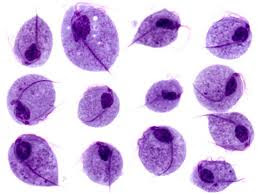Trichomonas vaginalis
Important features- it is a pear-shaped organism with a central nucleus and four anterior flagella; and undulating membrane extends about two-thirds of its length. It exists only as a trophozoite form, and measured 7-23μm long & 5-15μm wide. Transmission is by sexual intercourse.
Pathogenesis
The trophozoite is found in the urethra & vagina of women and the urethra & prostate gland of men. After introduction by sexual intercourse, proliferation begins which results in inflammation & large numbers of trophozoites in the tissues and the secretions. The onset of symptoms such as vaginal or vulval pruritus and discharge is often sudden and occurs during or after menstruation as a result of the increased vaginal acidity. The vaginal secretions are liquors, greenish or yellowish, sometimes frothy, and foul smelling. Infection in the male may be latent, with no symptoms, or may be present as self limited, persistent, or recurring urethritis.
Epidemiology
This parasite has worldwide distribution, and sexual intercourse is the primary mode of transmission. Occasionally, infections can be transmitted by fomites (toilet articles, clothing), although this transmission is limited by liability of the trophozoite. Rarely Infants may be infected by passage through the mother’s infected birth canal. The prevalence of this flagellate in developing countries is reported to be 5% –20% in women and 2% –10% in men.
Clinical features
Clinical disease - trichomoniasis. Most infected women at the acute stage are asymptomatic or have a scanty, watery vaginal discharge. In symptomatic cases vaginitis occurs with more extensive inflammation, along with erosion of epithelial lining, and painful urination, and results in symptomatic vaginal discharge, vulvitis and dysuria.
Immunity
The infection may induce humoral, secretory, and cellular immune reactions, but they are of little diagnostic help and do not appear to produce clinically significant immunity.
Laboratory diagnosis
• In females, T.vaginalis may be found in urine sediment, wet preparations of vaginal secretions or vaginal scrapings.
• In males it may be found in urine, wet preparations of prostatic secretions or following massage of the prostate gland.
• Contamination of the specimen with faeces may confuse T.vaginalis with T.hominis.
Prevention
- Both male & female sex partners must be treated to avoid reinfection
- Good personal hygiene, avoidance of shared toilet articles & clothing.
- Safe sexual practice.
INSTAGRAM








Hiç yorum yok:
Yorum Gönder